Mastering Remote Control: Your Computer via Smartphone

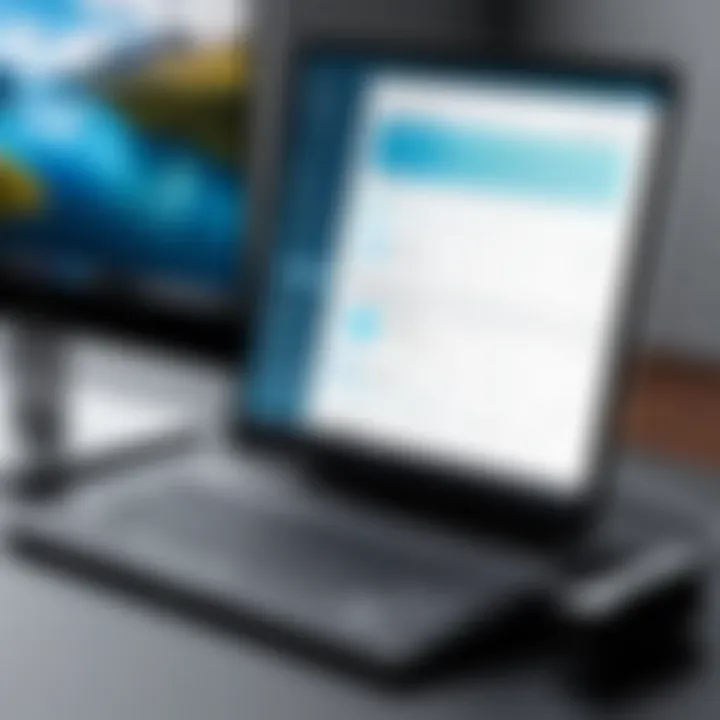
Intro
In today’s fast-paced digital environment, the ability to manage computer tasks remotely has become increasingly relevant. Many users seek seamless control over their computers using their smartphones. This capability not only enhances productivity but also aligns with the growing demand for convenient access to technology. Remote control solutions provide opportunities for both personal and professional use, transforming the traditional ways of interacting with computers.
With the right tools and setup, you can utilize your smartphone as an effective remote control device. It allows you to perform essential tasks, manage applications, and even transfer files, providing flexibility in how you interact with your digital environment. In this article, we will break down the various methodologies to achieve this, explore suitable applications, and outline the necessary configurations, focusing on ensuring security throughout the process.
As we delve into the intricacies of controlling your computer with your phone, we aim to equip you with the knowledge necessary to navigate various tools and solutions. By the end, you should feel confident in selecting and implementing a remote control strategy that suits your individual or organizational needs.
This guide will explore:
- Essential applications for remote computer access
- Configuration and setup for network accessibility
- Security metrics to maintain while executing remote control functions
- Practical applications for personal and professional use
The relevance of mastering these skills cannot be underestimated, especially with the rise of remote work and the need for efficient multitasking solutions. Let’s commence our exploration into this innovative technological integration.
Preamble to Remote Control Technology
The significance of remote control technology has surged in recent years, driven by an increasingly mobile society and the requirement for flexible access to computing resources. The ability to control one’s computer using a smartphone grants users remarkable convenience and efficiency. This transition represents not just a trend, but a fundamental shift in how we interact with technology.
Understanding Remote Access
Remote access allows users to connect to computers or network resources from a distance, making it possible to operate software as if they are physically present. This capability can reduce the constraints of time and geography, enabling users to manage tasks and access files when away from their primary computing devices. The applications of remote access are diverse, ranging from troubleshooting IT issues to accessing critical data on the go, providing flexibility and enhancing productivity.
In today’s fast-paced environment, understanding remote access is crucial. Users must be aware of the potential risks and security measures needed to safeguard sensitive information. Simple remote access tools can often mask complexities that become apparent in multifaceted systems, making it essential to possess foundational knowledge before implementation.
The Evolution of Remote Control Methods
Remote control methods have evolved significantly over the past few decades. Originally, the concept centered around traditional hardware setups, requiring physical connections and specific equipment, limiting accessibility. As technology has advanced, the rise of internet connectivity has transformed these methods, introducing software solutions that leverage cloud computing and wireless networks.
Today, a myriad of software applications allows seamless control over distant computers with a smartphone. Tools such as TeamViewer or AnyDesk are examples of this evolution, providing intuitive interfaces and multi-platform support. This shift not only democratized access to computer resources but created new avenues for business operations, support services, and collaboration.
The trends are showing no signs of reversing; instead, they continue to broaden the scope of work. The utilization of artificial intelligence and machine learning within remote control applications is on the rise, introducing features such as predictive analytics to enhance the user experience. Understanding how these technologies interplay offers insights that are essential when considering how to effectively control your computer with your phone.
Prerequisites for Controlling a Computer with a Smartphone
Before engaging in remote control of your computer using a smartphone, it is crucial to understand the prerequisites that ensure smooth and efficient operation. These prerequisites establish a solid foundation that maximizes the benefits of remote access. They include necessary hardware, the right network configuration, and compatible software. Each of these elements plays a significant role in the overall effectiveness of controlling a computer remotely.
Required Hardware
Hardware is the first aspect to consider when planning remote control of a computer. The smartphone needs to be running on a recent operating system, whether it's iOS or Android. Outdated hardware might not support the latest applications required for remote access.
For the computer, some hardware specifications also matter. A decent processor, a sufficient amount of RAM, and a stable internet connection are vital. Also, ensure that the computer’s firewall settings allow for remote connections. Some devices may require additional configurations, such as enabling remote desktop features in the operating system settings. Without the right hardware, remote access can be unreliable and frustrating.
Network Configuration
An optimal network configuration is another prerequisite essential for remote control. A good internet connection is required for both the computer and smartphone, preferably through high-speed Wi-Fi.
It is important to ensure that the firewall settings on the router allow remote access. Make sure to configure port forwarding correctly, which directs traffic from the external network to the correct internal IP address of your computer. Improper port forwarding can lead to connection failures or even security issues.
Also, consider setting up a Virtual Private Network (VPN) if accessing the computer from an unsecured network. A VPN adds an extra layer of security, guarding against potential unauthorized access. This ensures the connection is both stable and secure.
Software Requirements
Having the right software is just as necessary as hardware and network setup. Start by selecting a remote control application that suits your needs. Numerous options are available, such as TeamViewer, AnyDesk, or Microsoft Remote Desktop. Each application has distinct features that cater to various user requirements.
Ensure that both the smartphone and the computer have the appropriate software installed and that they are regularly updated. Updates often include critical security patches and improvements that enhance stability and performance. Additionally, consider the user interface and if it suits your comfort level.
In summary, ensure that you have proper hardware, a well-configured network, and the right software to establish an effective remote connection between your smartphone and computer. The importance of these prerequisites cannot be overstated as they form the backbone of a successful remote control experience.
Remote Desktop Applications
Remote desktop applications serve as a bridge between your smartphone and computer, allowing users to manage their PCs from a distance. This technology is crucial for enhancing productivity, enabling seamless transitions between different devices, and facilitating remote work environments. With a variety of options on the market, choosing the right remote desktop application influences user experience, efficiency, and security. Understanding the core functionalities and benefits of these applications can significantly impact the effectiveness of remote access solutions.
Overview of Popular Remote Desktop Apps
Several remote desktop applications are widely recognized in the industry, each offering unique features tailored to specific user needs. Some noteworthy applications include TeamViewer, AnyDesk, and Microsoft Remote Desktop. These applications allow users to connect to their computers seamlessly and perform tasks such as accessing files, running applications, and troubleshooting. The accessibility and effectiveness of these tools depend not only on their technical specifications but also on the compatibility with various operating systems.
Comparison of Features
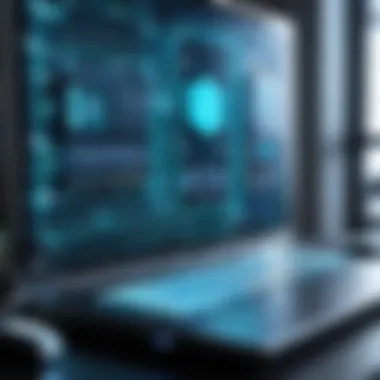
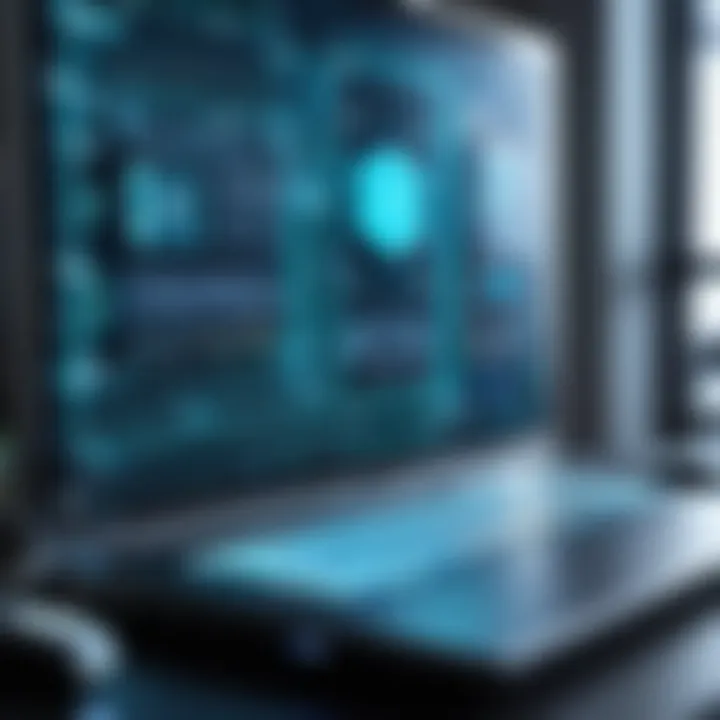
Accessibility
Accessibility is a key consideration when selecting a remote desktop application. This aspect refers to how easily users can connect their smartphones to their computers regardless of the location. A beneficial choice for many is TeamViewer, known for its cross-platform compatibility. It allows connections from iOS and Android to Windows, macOS, and Linux systems. One unique feature is its ease of use; users often appreciate the straightforward setup process. However, some may find the reliance on a stable internet connection a potential disadvantage, affecting accessibility in regions with poor connectivity.
User Interface
The user interface of a remote desktop application plays a crucial role in user experience. An intuitive interface allows users to navigate features with minimal effort, enhancing overall productivity. For example, AnyDesk offers a clean and uncluttered design, making it appealing to users of all technical skill levels. This simplicity can be a significant advantage for quick access to essential functions, but there is a downside in cases where advanced features may not be immediately apparent. Users looking for more complex functionalities might find the user interface limiting.
Security Features
Security features are paramount in remote desktop applications, especially when sensitive information is involved. Applications like Microsoft Remote Desktop utilize encryption protocols to protect data transmission. This characteristic renders it a suitable choice for professionals handling confidential information. While robust security enhances the application's value, it might introduce complications during setup, such as needing to manage firewall settings.
Pricing Structures
Pricing structures vary significantly among remote desktop applications. Some, like TeamViewer, offer free versions with limited features, which can be appealing for personal use. However, the costs can escalate quickly for commercial licenses. In contrast, AnyDesk has competitive pricing and offers a transparent, tier-based subscription model, making it easier for businesses to budget. Evaluating total cost versus required features is crucial for making an informed decision.
"The choice of remote desktop application can enhance your productivity and streamline remote work processes."
In summary, each popular remote desktop application presents distinct advantages and challenges. Understanding these variations enables users to select a solution that meets their specific operational needs.
Setting Up Your Smartphone for Remote Control
To effectively control your computer using your smartphone, proper setup is crucial. This stage encompasses the installation of necessary applications, configuration of specific settings, and ensuring the device permissions are aligned with your remote access requirements. Each of these elements contributes to a seamless user experience. When everything works together smartly, it amplifies the efficiency and convenience of remote control.
Installing Remote Control Software
The first step in setting up remote control is installing the right software on your smartphone. Applications such as TeamViewer, Chrome Remote Desktop, or AnyDesk provide varying features tailored to specific needs. Choosing the appropriate software is imperative because it dictates how well you can manage your computer from a distance. Installation processes are generally straightforward, involving downloading the app from your device’s app store. Each software often requires you to create an account, which is essential for establishing a secure connection.
Configuring Settings
After installation, configuration is the next logical step. This involves adjusting specific settings that enable your smartphone to communicate effectively with your computer.
User Accounts
User accounts are a significant aspect of remote control setup. Most applications require you to create or log into a user account. This account features various options, like easy access to multiple devices and permission management. The key characteristic of user accounts is their role in security. By requiring authentication, they ensure that only authorized users can gain access. This feature is beneficial as it protects your systems from unauthorized attempts, maintaining the integrity of your data. However, it translates to an added step in the initial setup process, which some users might find cumbersome but ultimately offers peace of mind.
Device Permissions
Equally important is the management of device permissions. This aspect determines what control or view your smartphone will have over the computer. Common permissions might include access to the screen, file system, and system controls. A notable characteristic of device permissions is their flexibility. Users can customize what is shared and what remains private. This selective access can limit potential vulnerabilities, making it a popular choice for many. However, over-granting permissions can lead to risks, particularly if malware enters the equation. Therefore, it’s wise to periodically review and adjust permissions to align with your security requirements.
Always ensure your remote access software is up-to-date, as updates often patch security vulnerabilities that can be exploited.
In summary, setting up your smartphone for remote control requires attention to detail. Installing the right software, configuring accounts, and managing permissions are foundational steps to ensure that your remote experience is both efficient and secure. This prepared environment allows for effective remote communication, facilitating better control over your computer while providing a user-friendly interface.
Connecting Your Smartphone to Your Computer
The process of connecting your smartphone to your computer is a crucial step in enabling remote access. This connection serves as the foundation for leveraging your phone's capabilities to control your computer effectively. It allows you to interact with your computer's interface, access files, and even perform tasks as if you were working directly at your desk.
A stable connection enhances overall user experience, ensuring smooth interactions. Without a robust link between the devices, latency and connection drops can hinder functionality, such as responding to commands or accessing remote applications. Thus, understanding how to establish and maintain this connection is essential for anyone looking to utilize their smartphone for computer control.
Establishing a Secure Connection
Establishing a secure connection requires careful consideration of your network setup and software choices. First, it usually involves using Wi-Fi or mobile data connections. Here are some practices to ensure a secure connection:
- Use Encryption: Make sure that the software you are using supports encryption. Apps like TeamViewer, AnyDesk, or Chrome Remote Desktop typically offer encrypted connections.
- Secure Your Network: Using a VPN can enhance security. This helps to prevent unauthorized access to your devices while you access them remotely.
- Two-Factor Authentication: Enabling this feature in the remote access software increases security layers, making it more difficult for hackers to gain access.
When these elements are in place, you can confidently control your computer knowing your data is protected.
Troubleshooting Connection Issues
Connection problems can be frustrating but addressing them promptly can improve your remote access experience. Here are common issues and their solutions:
- Network Issues: If you face frequent disconnections, check your internet connection. You can reset your router or switch to a more stable connection.
- Software Compatibility: Ensure that both your smartphone and computer are using compatible versions of the remote access app. Outdated applications might lead to unexpected issues.
- Firewall/Antivirus Interference: Sometimes, security software can block remote access applications. Adjust settings to allow the necessary permissions for the app to communicate unhindered.
- Device Permissions: Check if the app has the necessary permissions on both devices to function correctly. This includes permissions for microphone, camera, and network access.
"Troubleshooting can often resolve many connectivity issues quickly, allowing for seamless remote control functions."
Following these guidelines will help in easily connecting your smartphone to your computer without major setbacks.
Using Your Phone as a Remote Control
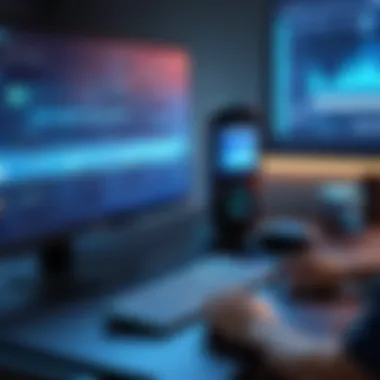

In today’s digital age, controlling your computer with your phone has evolved from a novelty to a necessity. The ability to operate a computer remotely via a smartphone allows for greater flexibility and convenience. This approach offers users the chance to access files, applications, and settings without being tied to a desk. The integration of smartphones as remote control devices significantly streamlines workflows in both personal and professional activities.
With the rapid advancements in technology, utilizing your smartphone as a remote control enhances overall productivity. For instance, imagine giving a presentation from your phone while controlling your computer from across the room. Moreover, remote control via smartphones enables better management of tasks with ease. Thus, understanding the basics and advanced features of this functionality is vital for users aiming to leverage the full potential of remote access.
Basic Controls and Navigation
Basic controls allow users to navigate their computer systems effectively. This typically includes mouse-like functions such as clicking, scrolling, and dragging. Many remote control applications mirror the functions of a computer mouse, enabling seamless transitions between devices.
Here are some common basic controls:
- Mouse Controls: Users can use their fingers to simulate left and right mouse clicks.
- Scrolling: Vertical and horizontal scrolling can be managed with finger gestures, typically by swiping on the touchscreen.
- Keyboard Access: Virtual keyboards allow for typing on the computer, opening up communication and document editing functionalities.
Using these controls, users can quickly access applications, navigate menus, and perform tasks without directly physical interaction with the computer itself. Understanding these controls is essential for maximizing remote control efficiency.
Advanced Features Utilization
Advanced features can significantly enhance the remote control experience. Many remote desktop applications offer functionalities that go beyond simple interaction, enabling users to manage their computers more effectively.
File Transfers
File transfers allow users to move files between their smartphone and computer. This is especially useful for professionals who need to access important documents on the go. The primary characteristic of this feature is its ease of use, enabling seamless transfer without complicated steps.
- Key Benefit: Quick access to files enhances productivity.
- Unique Feature: Drag and drop functionality in some applications simplifies file transfer.
- Advantage: Instant access reduces the need to email files back and forth, saving time.
- Disadvantage: Users should be cautious of file security during transfers, especially over unsecured networks.
System Monitoring
System monitoring features provide insights into computer performance directly from the smartphone. This facilitates better management of resources and ensures systems run efficiently. The core characteristic of this feature lies in its real-time monitoring capabilities.
- Key Benefit: Immediate alerts for system issues can enhance troubleshooting efforts.
- Unique Feature: Some applications provide dashboards that display CPU usage, memory utilization, and network health.
- Advantage: Monitoring helps maintain optimal system performance.
- Disadvantage: Continuous monitoring may lead to battery drain on the smartphone due to the added workload.
The evolution of smartphone capabilities has transformed the way users interact with their computers, making remote control not just feasible, but essential for modern efficiency.
Security Considerations
In the age of remote work and digital connectivity, the integration of smartphones and computers presents both convenience and security challenges. Security considerations play a crucial role in maintaining the safety of personal and professional data while using smartphone remote control options. With the capability to access sensitive files and applications on a computer through a mobile device, users must be aware of the risks and take appropriate measures to secure their connections.
Ensuring Safe Remote Access
The first step in ensuring safe remote access is user authentication. It is important to use strong passwords and, if possible, two-factor authentication. This adds an extra layer of security that is critical when accessing devices remotely. Enabling features like biometric login on smartphones, such as fingerprint or facial recognition, can also enhance safety.
Regularly updating remote access applications is another essential practice. Outdated software can harbor vulnerabilities that attackers might exploit. Keeping both the smartphone and computer updated not only improves performance but also ensures that patched security flaws are addressed.
Furthermore, using a Virtual Private Network (VPN) can be very beneficial. A VPN encrypts your internet connection and helps to mask your IP address, making it harder for unauthorized individuals to intercept your data. This is particularly important when connected to public Wi-Fi networks which are often less secure.
Identifying and Mitigating Risks
Understanding the potential risks associated with remote access is crucial for users. Common risks include unauthorized access to your devices, data leaks, and malware infections. Users need to be vigilant and recognize indicators of suspicious activities. For instance, if a remote access application behaves unexpectedly or if there is unfamiliar login activity related to your account, immediate action is necessary.
To mitigate these risks, consider the following strategies:
- Limit Access: Only provide remote access to trusted devices and users. Regularly review permissions and remove access when it's no longer necessary.
- Monitor Activity: Most remote access tools offer logs of recent activity. Regularly check these logs for any unusual or unauthorized access attempts.
- Use Security Software: Employing antivirus and anti-malware solutions can also protect against threats. These programs can help detect and eliminate unwanted software that compromises your data.
As remote access technology continues to evolve, staying informed about new risks and corresponding mitigations is vital. By enhancing awareness around security considerations, users can confidently harness the power of remote control technology while safeguarding their systems.
Use Cases for Remote Control
Understanding how to control a computer with a smartphone offers numerous practical applications. This capability is not only a technological marvel but also a tool that enhances productivity and flexibility in various settings. By exploring the specific use cases, users can appreciate how remote control can fundamentally improve work processes, streamline personal tasks, and transform interactions with technology.
Personal Uses
The personal applications of remote control technology are extensive and can dramatically improve day-to-day activities. For instance, one might need to access important files while away from home. With a smartphone, users can easily connect to their personal computer and retrieve necessary documents. This flexibility proves valuable when someone forgets to email themselves a file prior to leaving the house.
Another critical personal use case includes remote troubleshooting. Individuals can assist family members or friends who face technical issues by accessing their computers remotely. This support can save time and effort that would otherwise require an in-person visit. Additionally, users can control media playback on their home computers for entertainment purposes. This functionality is beneficial when using a home theater system controlled by a computer, allowing users to operate it comfortably from their couches.
Professional Applications
In a professional context, the benefits become even more pronounced. Businesses increasingly adopt remote work policies, meaning employees often need access to their office computers outside of conventional hours. With smartphone access, employees maintain productivity without being tethered to a desk. This connectivity is crucial in environments where time-sensitive tasks must be completed efficiently.
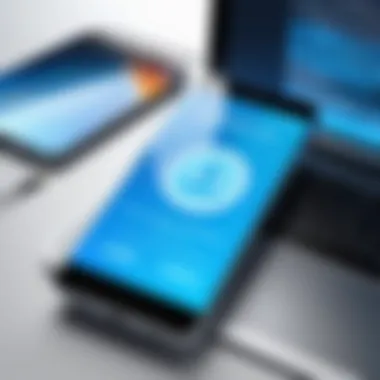
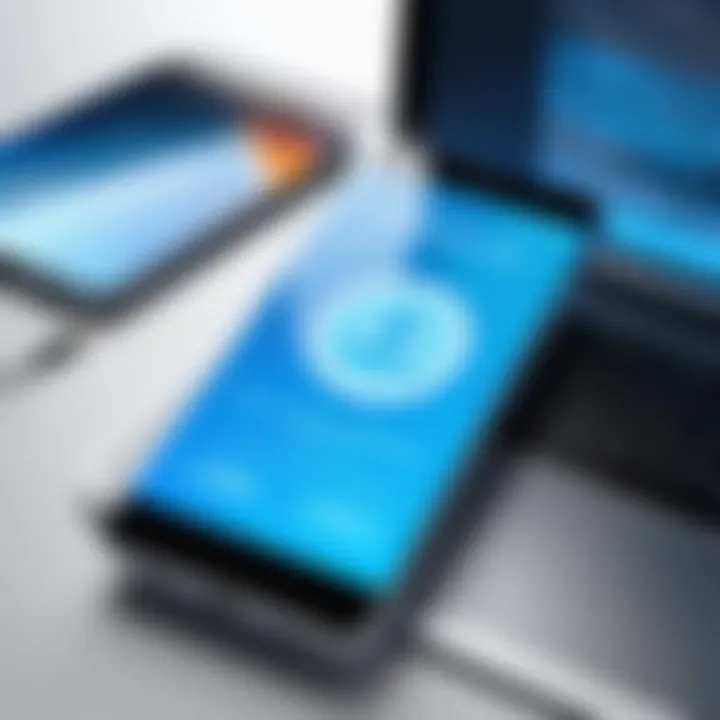
Moreover, professionals in fields such as IT or technical support can utilize remote access to offer immediate assistance to clients or staff. Resolving issues remotely saves money for both the technician and the client. It can also minimize downtime for systems that require urgent attention, enhancing overall efficiency in business operations.
Additionally, collaboration tools that integrate remote control functionalities allow teams to work together seamlessly, regardless of location. Team members can share screens during video calls to present ideas, analyze data, and provide input swiftly, leading to more dynamic and productive meetings.
Remote control capabilities transform how individuals and organizations operate, fostering an environment of continuous connectivity and responsiveness.
Ultimately, whether for personal convenience or professional effectiveness, remote control solutions have become an essential component of modern digital interaction. The demands of contemporary life necessitate a reliable means of controlling computers remotely, an area where smartphones excel.
Alternatives to Smartphone Control
The ability to control a computer remotely is not limited to smartphones alone. Understanding the alternatives widens the scope of accessibility and provides flexibility in choosing the best method for remote interaction. This section will explore alternatives such as tablets and smart home devices and their relevance in the context of remote control technology.
Using Tablets and Other Devices
Tablets have emerged as a popular alternative to smartphones for remote control purposes. They often offer larger screens and a comfortable interface for users, enhancing the overall experience. Tablets like Apple iPad and Samsung Galaxy Tab can run similar applications to those used on smartphones, such as TeamViewer, AnyDesk, or Microsoft Remote Desktop.
Key benefits of using tablets include:
- Better Screen Size: The larger display allows for easier navigation and improved visibility of complex software applications.
- Enhanced User Interface: Tablets often provide a more suitable user interface that can simplify complex tasks and improve productivity.
- Multi-Functionality: Tablets can act as both personal devices and remote control terminals, providing versatility in usage.
While tablets have various advantages, it is essential to consider some limitations. For instance, not all remote desktop applications may be optimized for tablet use. This could lead to a subpar experience, especially if the application is designed primarily for a smartphone interface.
Integration with Smart Home Devices
With the rise of the Internet of Things, smart home devices have also become viable options for controlling computers remotely. Devices such as Amazon Echo, Google Nest Hub, or other smart displays can integrate with home networks and offer control functionalities. By linking these devices to the right software, users can execute commands and control applications on their computers.
The integration options are numerous and include:
- Voice Commands: Users can issue voice commands to control their computers, making the experience hands-free.
- Remote Task Management: Through smart displays, users can manage tasks on their computers, check calendars, and receive notifications without needing another screen.
- Simplified Automation: Smart home devices can automate repetitive tasks by scripting commands that run on the computer based on set criteria.
However, users must carefully evaluate the compatibility of their computer systems with smart home technology to ensure a seamless experience. Additionally, the need for a stable network connection becomes even more pressing when relying on multiple devices.
Integrating tablets and smart home devices adds flexibility to remote control options. It allows for various usage scenarios that can maximize efficiency and convenience.
In summary, while smartphones are a popular choice for remote access, tablets and smart home devices offer valuable alternatives that may suit different needs and preferences. Whether for personal or professional applications, these alternatives can provide considerable advantages, enhancing user experiences and broadening the capabilities of remote technology.
Future Perspectives on Remote Control Technology
Remote control technology has become increasingly significant in enhancing productivity and lifestyle efficiency. Understanding the future perspectives in this domain is crucial, especially for IT professionals and businesses looking to leverage these advancements. The evolving landscape is expected to bring pivotal changes, marked by emerging trends and potential innovations, making remote access not only easier but also more secure and versatile.
Emerging Trends
Several trends are transforming the realm of remote control technology. Firstly, cloud integration has become rampant. More applications are shifting towards the cloud-based model, allowing users to access their systems from anywhere without complex setup processes. This is particularly beneficial for businesses operating on a global scale, where team members often work remotely.
Another significant trend is the rise of artificial intelligence (AI) in remote control applications. AI can streamline connection processes, predict user needs, and even enhance security measures by identifying unusual access patterns. For instance, AI-driven tools can analyze usage behavior to suggest optimized settings or proactively alert users of potential threats.
- Cross-Device Compatibility: With the rapid adoption of various devices, there is a notable push towards apps that function seamlessly across smartphones, tablets, and computers. This interoperability ensures a consistent user experience regardless of the device.
- Enhanced Security Protocols: As remote access increases, so do security threats. Innovations centered around improved encryption and multi-factor authentication are on the rise, thus ensuring that sensitive data remains protected.
The integration of Internet of Things (IoT) devices is also notable. For instance, controlling a computer via smartphone can extend to managing smart home systems, creating an interlinked network of control.
Potential Innovations
Looking ahead, innovation in remote control technology shows promise in various fields. One area of potential is augmented reality (AR). AR could redefine how users engage with their machines, allowing them to manipulate digital interfaces by merely pointing their smartphones at their computer screens. This interaction can vastly enhance user experience, especially in creative industries where design versatility is critical.
Another imaginative innovation is biometric authentication. The integration of biometric features, like facial recognition or fingerprint scanning on smartphones, offers an extra layer of security when accessing computers remotely. This could greatly reduce the risks associated with unauthorized access.
Finally, machine learning algorithms are set to advance remote control functionalities. By learning user behavior over time, these algorithms can optimize control settings dynamically, adjusting performance to suit individual preferences. This capability would result in a smoother operating experience while ensuring efficiency.
\n
End
In an age increasingly characterized by mobility and connectivity, controlling your computer via your smartphone emerges as an invaluable capability. This guide has navigated through a range of elements essential for harnessing this potential, shedding light on how technology converges to enhance productivity and user experience.
Summary of Key Points
- Remote Access Significance: Understanding the fundamentals of remote access lays the groundwork for effective control. This knowledge empowers users to make informed decisions about applications and configurations.
- Hardware and Network Requirements: Correct hardware selection and network setup are critical. Users must ensure their devices and connections are optimized for seamless interaction.
- Software Solutions: Familiarity with various remote desktop applications and their features enables tailored choices that fit specific needs. Each application presents unique benefits that cater to different scenarios, from casual use to professional settings.
- Usage Techniques: Comprehensive guidance on utilizing smartphones effectively for remote control reinforces user capability. From basic controls to advanced features, the potential is wide-ranging.
- Security Concerns: The importance of security cannot be overstated. Employing best practices and understanding potential risks ensures that remote access remains safe and reliable.
- Emerging Trends: Keeping an eye on future developments in remote control technology is crucial. Innovations often lead to enhanced functionalities and better user experiences.
Final Thoughts on Remote Control Solutions
The ability to manage your computer from your phone opens doors to flexibility and efficiency. Users can access files, execute commands, and troubleshoot issues without being tethered to their workstations.
This capability is not merely a convenience; it is becoming integral for both personal and professional environments. As businesses continue to adapt to remote and hybrid models, the relevance of mobile control solutions will only increase.
Remote control technology is reshaping how we interact with devices, ensuring accessibility and control at our fingertips.



